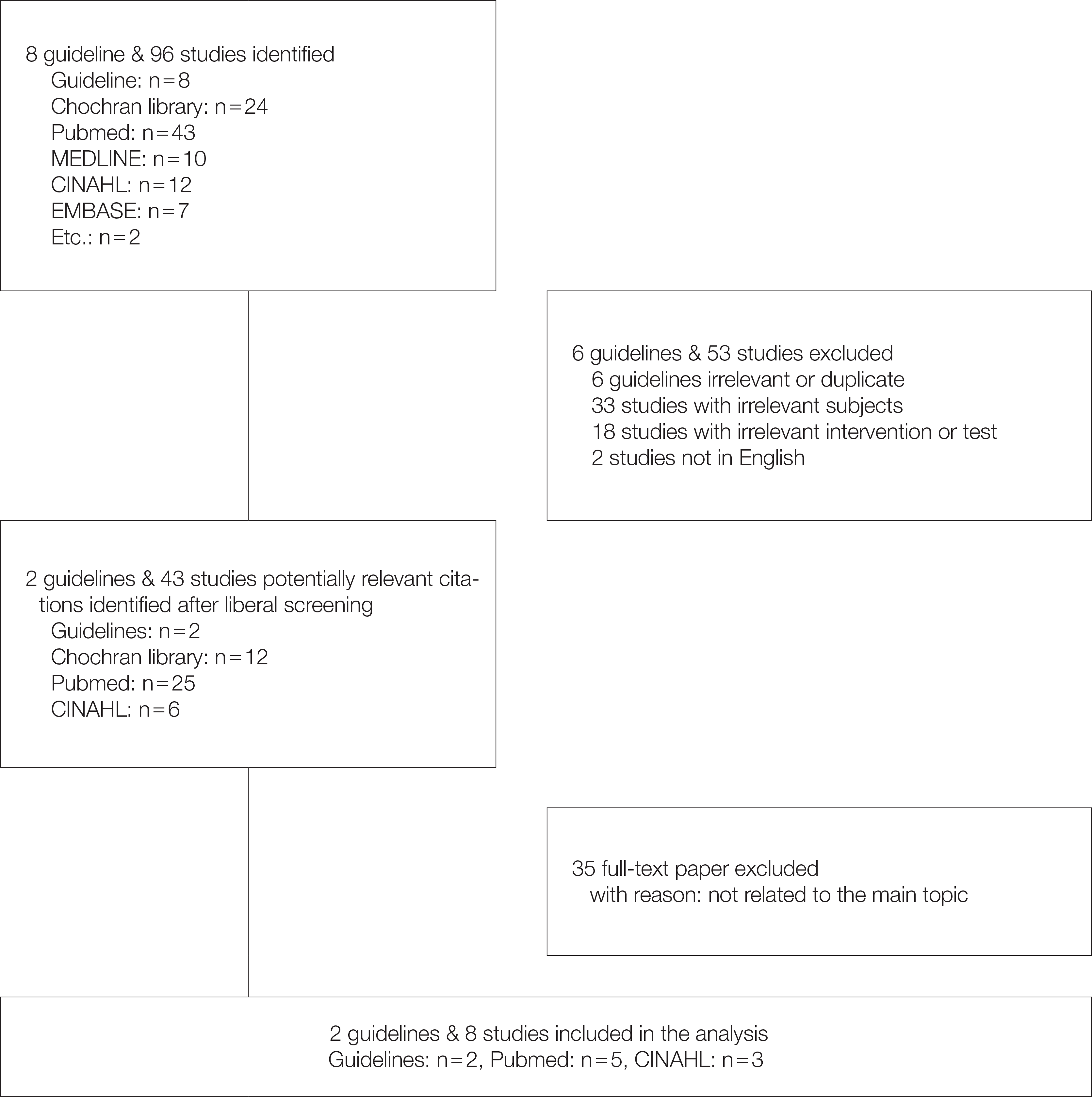초록
Purpose
This study aimed to develop and evaluate the lower extremity lymphedema nursing practice protocol for patients following gynecologic cancer treatment.
Methods
Thirteen web-sites were searched for eligible clinical practice guidelines (CPGs) and eleven databases were searched to identify evidence to develop a lower extremity lymphedema nursing practice protocol for patients following gynecologic cancer treatment.
Results
Based on the inclusion and exclusion criteria, eight CPGs and ninety-six studies, two guidelines and eight studies were identified as evidence. The protocol development group consisted of ten experts who have at least five years’ experience in the related area. A lower extremity lymphedema nursing practice protocol for patients following gynecologic cancer treatment was developed including forty-three recommendations in five domains. Significant differences were found in nurses’ pre and post knowledge and confidence on lower extremity lymphedema prevention and management.
Go to : 
REFERENCES
1. National Cancer Information Center (KR). Annual report of cancer statistics in Korea in 2014 [Internet]. Available from. http://www.cancer.go.kr/. [Accessed August 9, 2017].
2. Abu-Rustum NR, Alektiar K, Iasonos A, Lev G, Sonoda Y, Aghajanian C, et al. The incidence of symptomatic lower-extremity lymphedema following treatment of uterine corpus malignancies: a 12-year experience at Memorial Sloan-Kettering Cancer Center. Gynecol Oncol. 2006; 103:714–8.

3. Kang SH, Hwang KH, Sim YJ, Jeong HJ, Lee TH, Kim SH. The prevalence and risk factors of lower limb lymphedema in the patients with gynecologic neoplasms. Korean J Obstet Gynecol. 2009; 52:815–20.
4. Warren AG, Brorson H, Borud LJ, Slavin SA. Lymphedema: a compre-hensive review. Ann Plast Surg. 2007; 59:464–72.
5. Yang HS, Lee K, Kim DS, Sim YJ, Jeong HJ, Kim GC, et al. The association of social support and quality of life in gynecological cancer related of lymphedema in a hospital: a pilot study. Korean J Obstet Gynecol. 2011; 54:355–60.

6. Kim C, Lee G, Kim D, Kim J, Kim J, Lee H, et al. Literature prospective lymphedema of physical therapy. J Korean Soc health Sci. 2014; 11:69–76.
7. Lee Y, Lim MC, Joo J, Park K, Lee S, Seo S, et al. Development and validation of the Korean version of the female sexual function index-6 (FSFI-6K). Yonsei Med J. 2014; 55:1442–6.

8. Kim MY, Hwang EK. Development and validation of a knowledge scale for lymphedema in patients with breast cancer. Korean J Rehabil Nurs. 2012; 15:117–25.

9. Ministry of Health & Welfare, Korean Academy of Medical Science. Adaptation process for developing Korean clinical practice guidelines [Internet]. Available from. http://www.guideline.or.kr/contents/index.php?code=148. [Accessed August 20, 2017].
10. Medical Education Partnership Ltd. Best practice for the management of lymphoedema: an international consensus [Internet]. Available from. http://www.woundsinternational.com/media/issues/210/files/con-tent_175.pdf. [Accessed August 20, 2017].
11. Korean Society of Lymphedema. Clinical practice guideline for lymph-edema following cancer treatment [Internet]. Available from. http://www.kslymph.or.kr/file/151204.pdf. [Accessed August 20, 2017].
12. The AGREE Research Trust. Appraisal of guidelines for research & evaluation II, AGREE II instrument [Internet]. Available from. http://www.agreetrust.org. [Accessed August 9, 2018].
13. Scottish Intercollegiate Guidelines Network (SIGN). SIGN 50, a guideline developer's handbook [Internet]. Available from. http://www.sign.ac.uk. [Accessed August 20, 2017].
14. Gu MO, Cho YA, Cho MS, Eun Y, Jeong JS, Jung IS, et al. Adaptation of intravenous infusion nursing practice guideline. J Korean Clin Nurs Res. 2013; 19:128–42.
15. Mermel LA, Allon M, Bouza E, Craven DE, Flynn P, O'Grady NP, et al. Clinical practice guidelines for the diagnosis and management of intravascular catheter-related infection: 2009 Update by the Infectious Diseases Society of America. Clin Infect Dis. 2009; 49:1–45.

16. Choi BR. RAM (RAND/UCLA appropriateness method) applied to decision making method. HIRA Policy Trends. 2010; 4:58–62.
17. Field MJ, Lohr KN. Clinical practice guidelines. Directions for a new program [Internet]. Available from. http://nap.edu/1626. [Accessed March 1, 2016].
18. Kim HS. Effects of the nursing process education program on critical thinking dispositions of the nursing students. J Korean Data Anal Soc. 2015; 17:561–74.
19. Cho YA, Eun Y, Gu MO, Kim KS, Kwak MK, Kim JH, et al. Development of oral care nursing practice guideline using the guideline adaptation process. J Korean Clin Nurs Res. 2015; 21:154–68.
20. Jeong IS, Park KH, Song BR, Sim KH, Han EJ, Hong EY, et al. Development of clinical practice guideline by adaptation: diabetic foot care. J Korean Clin Nurs Res. 2015; 21:196–206.
21. Cho YA, Gu MO, Eun Y, Kim KS, Lee SH, Yoon JH, et al. Nursing practice guideline for prevention of venous thromboembolism according to the guideline adaptation process. J Korean Clin Nurs Res. 2016; 22:118–31.
Go to : 
Table 1.
Guideline Appraisal Using AGREE Tool
Table 2.
SIGN Classification of Reviewed Studies
Table 3.
Protocol Contents, Strength and Level of Recommendation
Table 4.
Effect of Nurses’ Knowledge and Confidence on Lymphedema Prevention and Management for Patients after Gynecologic Cancer Treatment




 PDF
PDF ePub
ePub Citation
Citation Print
Print



 XML Download
XML Download